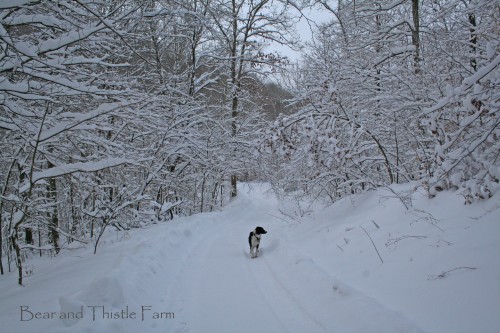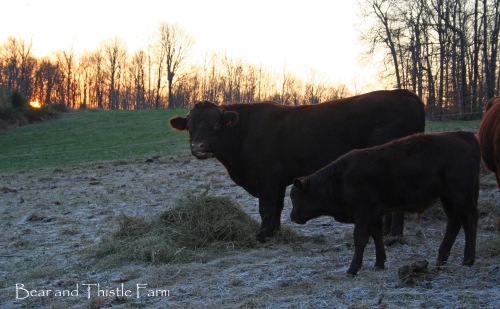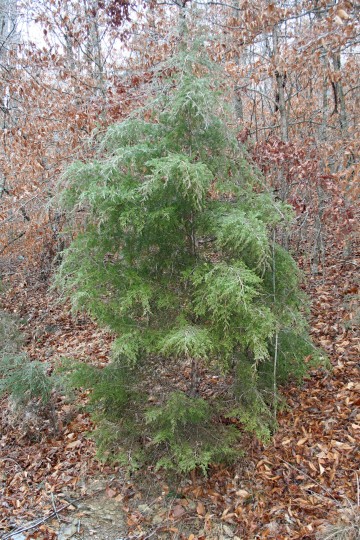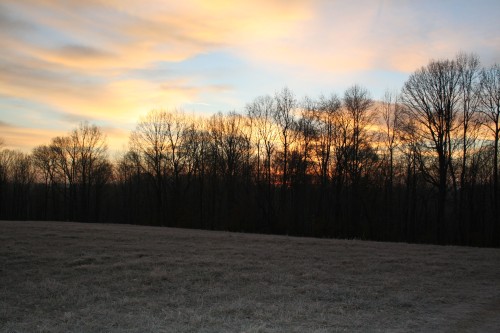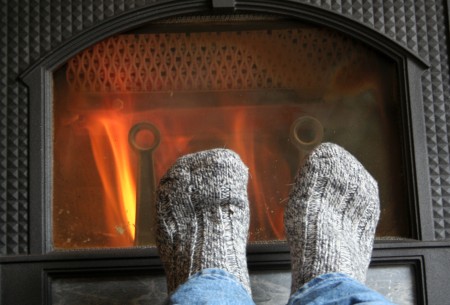
I must admit, I enjoyed the taste of a winter wonderland at the Farm. My apologies to all of you in Virginia, Maryland, Pennsylvania, New York and Oklahoma who are still dealing with a super abundance of the white stuff and are sick of it. We only had a couple of inches there in south-central Kentucky, starting the third day, and it was gone by day six. Temperatures in the teens and low twenties ensured our winter working visit was sufficiently wintry, requiring the donning of insulated coveralls, vests, multiple hats and gloves for all the outdoor work, but thankfully the snowfall was limited.
The cold kept my photo-documentation of this trip to a bare minimum, I’m sorry to say. It was too cold and I was too busy to set the camera up for self-shots; too cold also, to get the Bear to lend a hand and work the shutter. So it goes. I managed a couple of stomps around to take a few pictures of the wintry roads, the house and shop, the icicle-adorned creek, the snow-frosted pastures and pond, but of the projects and work accomplished, nothing.
I’ll do better next time. But the work got done, pictures or no. It was a very good Farm visit.
I had hoped for dry weather and lightly frozen ground so I could chop down the summer’s growth on the pastures with the tractor and bush hog – work that should have been done in September or October, but we had fences to build and gates to hang in September, so the pastures hadn’t been mowed since spring. Not the end of the world, pastures don’t always need mowed to do well; but the cover is so thick and ungrazed on mine, the dry matter left standing at the end of the growing season is too substantial to break down without some mechanical shredding. I figured a winter mow, though unorthodox, might work.
I got lucky this trip. Conditions weren’t perfect, but I did get all but the little 3-acre west pasture mulched down, ready for the rains to work the chopped material into the soil where it can feed my micro-livestock there. Unchopped, untrampled forage held above the soil by height or bulk, may take several years to decompose, even in Kentucky’s rain-blessed environment. Soil contact is essential, and the bush hog does a fabulous job of shredding the grasses and pushing them down to the surface for the new grasses to grow through. Grazing animals would, of course, be the ultimate pasture management tool, but until I’m there full-time, my little tractor must suffice.
ready for the rains to work the chopped material into the soil where it can feed my micro-livestock there. Unchopped, untrampled forage held above the soil by height or bulk, may take several years to decompose, even in Kentucky’s rain-blessed environment. Soil contact is essential, and the bush hog does a fabulous job of shredding the grasses and pushing them down to the surface for the new grasses to grow through. Grazing animals would, of course, be the ultimate pasture management tool, but until I’m there full-time, my little tractor must suffice.
It was a good opportunity to observe the wet areas between the ponds, where surface moisture persists in scattered depressions in all but the driest months. The folks had mentioned standing water in the fields over the years, but I’d not had the chance to assess the boundaries of where this occurs; this trip I was able to see the acre or so of what may very well be permanent wetland that appears to be spring-fed, draining slowly to either side of the crest of the top pasture into the two ponds. I will stake it out in the spring when we are back, and let it alone to see what it does through the seasons. It may be an ideal place for a wetland hedgerow of native plants; though it would take some pasture out of production, there is much benefit to be derived from the diversity of another plant community on the farm.
Before I could start the tractor work, though, we had to drain the hydraulic fluid as it checked white and foamy, indicating water had seeped in. I believe Bobby had left Jack out in the rain last Fall – old tractors like this aren’t weatherproof, and water will get in unless the housing is covered. So we did that, along with the rear differential, because the PTO wasn’t disengaging properly and we thought it might be a fluid problem. It was. The shop manual sent us on a goose chase for the rear differential’s check plug that ended up being a hidden screw on the side of the housing behind the brake pedals, which had to be loosened and moved out of the way to access the screw. It didn’t appear to have been opened in a long time. We drained approximately 6 gallons, and the book said that was the capacity; but filling it took only 5 before the fluid started coming out of the check hole. The front end loader added to the system probably accounts for the difference. We think it was overfull the entire time, getting filled to the recommended amount without checking the level, which would explain the constant leakage underneath and the PTO malfunction.
So a day of tractor maintenance, and evenings cleaning and setting up the shop was time well spent.
Heading up to Louisville on Thursday for our flight home, we had no idea that Dallas had received a foot of snow and the airport had cancelled all incoming flights. With no TV, no Internet, no national newspaper, and just radio news, which focused on the snow being dumped on the Mid-Atlantic but never mentioned Dallas, it didn’t occur to us to call and check before we left. So back to the Farm we went, and the next morning’s flight was cancelled too, leaving us with a flight out on Sunday at the earliest.
I confess I was not very upset to have to return to the farm for another couple of days. My job list for our Spring trip includes repainting the corral panels that have been sitting out rusting for 8 years or more, so Friday afternoon I was able to get them all moved down to the shop, ready for sanding and rust treatment and painting come April. Saturday was cold and cloudy with scattered snow flurries, but I bundled up in my insulated coveralls and spent the day taking down (finally!) the barbed wire lanes that surrounded the pond and corral. Posts will get pulled next visit, and mowing should be infinitely easier without the fences and gate setup that was no longer in use and badly situated to begin with.
Returning to San Diego on Valentine’s Day, the captain announced our descent into Lindbergh Field around 5 pm and noted the temperature: 72 degrees. I smiled, and thought of the frosty fields, snow-kissed woods and frigid temps we’d just left, and of all the good work we got done. And the little farmhouse, buttoned up behind the gates and fences, with lights that come on in the evenings, waiting for our return. I can’t wait to get back.

Read Full Post »
